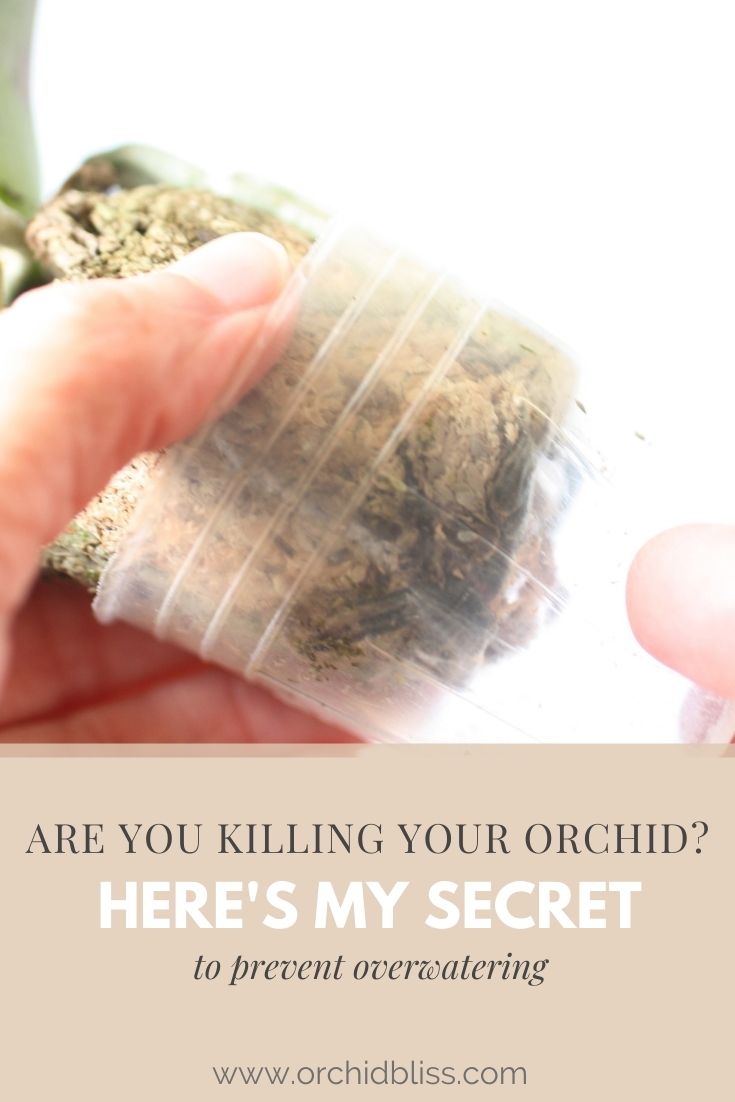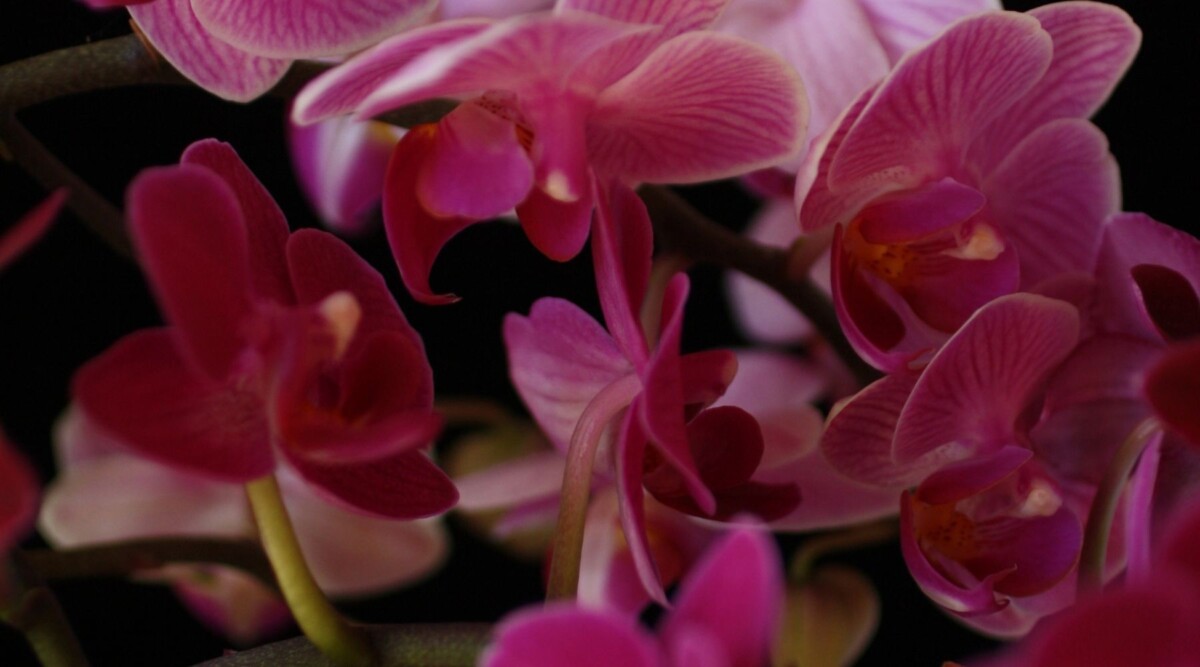
Espresso Orchid Care: The Complete Guide
Espresso orchids are popular for small indoor spaces. Their compact size makes them perfect for windowsills and powder rooms. It also makes their care a little different than that of regular-sized orchids.
Espresso orchids require lots of light, well-draining soil, and more water than their full-sized cousins. Their roots enjoy being misted often but being fertilized sparingly. When properly cared for, these plants will reward you with repetitive blooms throughout the year.
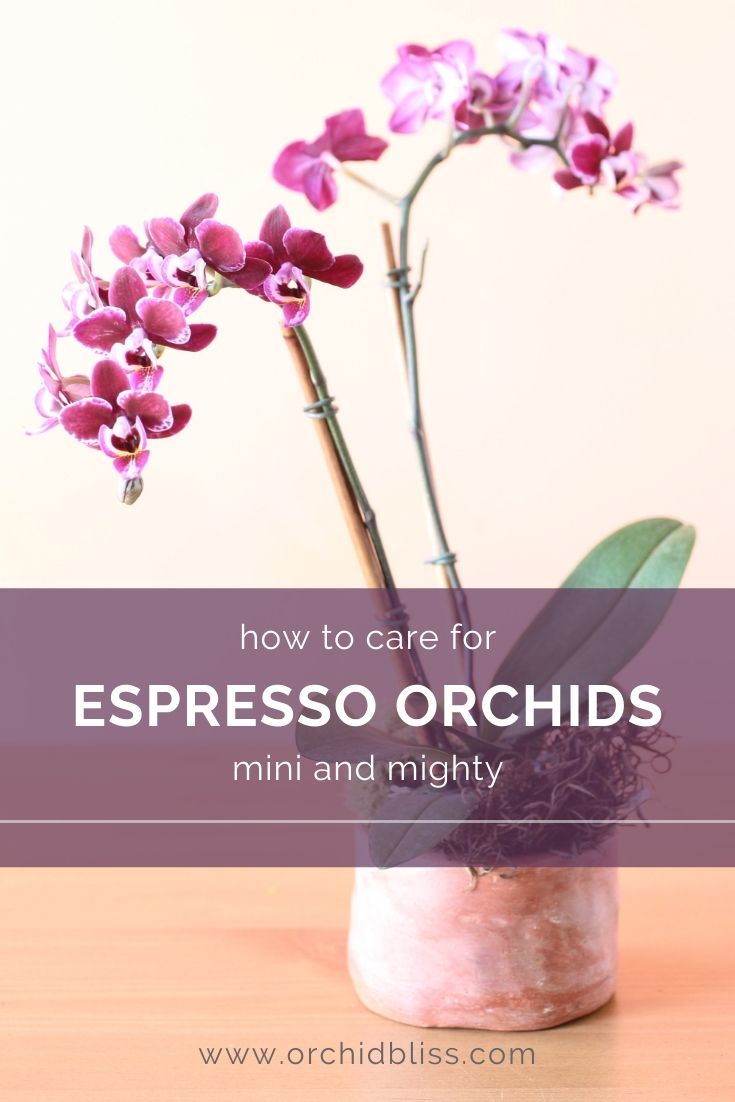
Some of the links on this page may be affiliate links. Click here to learn more.
Orchids scare away many plant owners with their reputation of being difficult. In this article, we’ll provide you with all the tools you need to keep an espresso orchid healthy and get past your orchid fears.
The Espresso Orchid
Technically a type of phalaenopsis orchid, the espresso orchid is a miniature flower often kept in two or three-inch pots. Most phalaenopsis orchids grow to be about a foot (12 inches) tall, but espresso orchids usually cap out at half a foot (6 inches) tall. While these orchids are small, they can still grow to have two separate bud-producing spikes, giving you many flowers from a little plant.
These miniature specimens are recognizable not only by their size but by their elegant shape. A tall, arching stem, often reinforced by a supportive stake, bears colorful and open flowers along its curve. A splay of solid green leaves reach out over the pot’s brim at the stem’s base. This explosive greenery creates a pleasant balance on what would be an otherwise top-heavy plant.
To help you further, start by downloading my free cheat sheet to see where to cut the orchid flower spike after blooms have faded to trigger re-blooming. Click here for the cheat sheet. It’ll be super helpful.
Espresso Orchid Accessories and How to Use Them
While you can often make things work when it comes to houseplants, it’s sometimes easier to invest in the proper equipment. A few items could make your life with an espresso orchid much easier.
Misting Bottle
All orchids love humidity. Blame it on their native climates, where they usually experience daily dew and record rainfall. Both warm and cold climate orchids like humidity, though the warm-climate varieties usually enjoy higher moisture levels and higher temps.
Misting the leaves can lead to bacterial spotting and doesn’t increase humidity. In that way, misting leaves is not helpful.
However, when you mist the roots of your plant, it gives the plant more of a chance to absorb moisture throughout the day while not technically raising the humidity of the room. Think of misting as a mini-watering for plants that love moisture, like orchids. Avoid misting the leaves to avoid bacterial and fungal infections.
Note that the word misting implies a delicate application of water, not a full drenching one. You’ll want a device built to do just that to achieve this light spritzing. Sure, you can use a simple plastic spray bottle, but such an elegant plant deserves an elegant mister. The Ebristar Glass Plant Mister not only produces a fine spray but also serves as a decor piece when not in use.
Tip: Mist your orchid’s roots in the morning. That will ensure the water has a chance to be used or evaporate during the day. The liquid that sits on a plant for an extended time can easily produce harmful bacteria.
Support Stakes
As mentioned, espresso orchids are often sold with stakes that support their stems. If your plant is not sold with one of these, you might want to look into purchasing some. These sticks act as reinforcement for the delicate plant’s stem if their bloom production adds too much weight or the top of the stem begins to arc an extreme amount.
On the other hand, your orchid’s flower stalk may be strong and stiff. If this is the case, you can safely remove the flower stake. Save it, as it may useful for another orchid.
Narrow-Spout Watering Can
Two ways to water your espresso orchid are: a full weekly soaking or biweekly watering can pour over. The first is a great way to spend some time with your orchid, but it also takes time, which might not work for some people.
When you opt for the weekly soaking method, you’ll take the orchid’s plastic container or remove it from the decorative pot if it’s in one, and then place the entire container in a sanitized bowl of room-temperature water. Leave the plant to soak for 20 minutes, and then let it drain before putting it back in its place. This in-depth soaking will usually satisfy the roots of the espresso orchid for a full week. Take care to only soak the pot and not the leaves or flowers.
If you opt for the watering can pour-over method, you’ll likely need to water your orchid twice a week, as it doesn’t provide as thorough of a saturation. To do this, you’ll still need to remove the plastic pot from the decorative container if it is in one. Place the plastic pot in the sink, and pour water over the soil’s surface evenly until it runs out of the bottom drainage holes.
A narrow-spout watering allows you to apply water precisely to the orchid’s roots without soaking the leaves or stem. Don’t forget that your espresso orchid is probably living in a minuscule two or three-inch pot. These tiny containers can easily become flooded by regular-sized watering cans. A Long Spout Watering Can offer precise water application without restricting water flow to a painfully slow point.
PRO TIP: If your orchid is potted in sphagnum moss, an effective way to prevent overwatering is to simply remove the plastic liner pot. Your orchid’s roots will thrive!
Orchid Fertilizer
Orchids are extremely susceptible to fertilizer burn. Their wide-open roots are doused with water daily in the wild, which provides regular cleaning and removal of abrasive salts, which orchids have become sensitive to. When brought into the home, these plants don’t receive such a regular soaking, yet their roots remain particular.
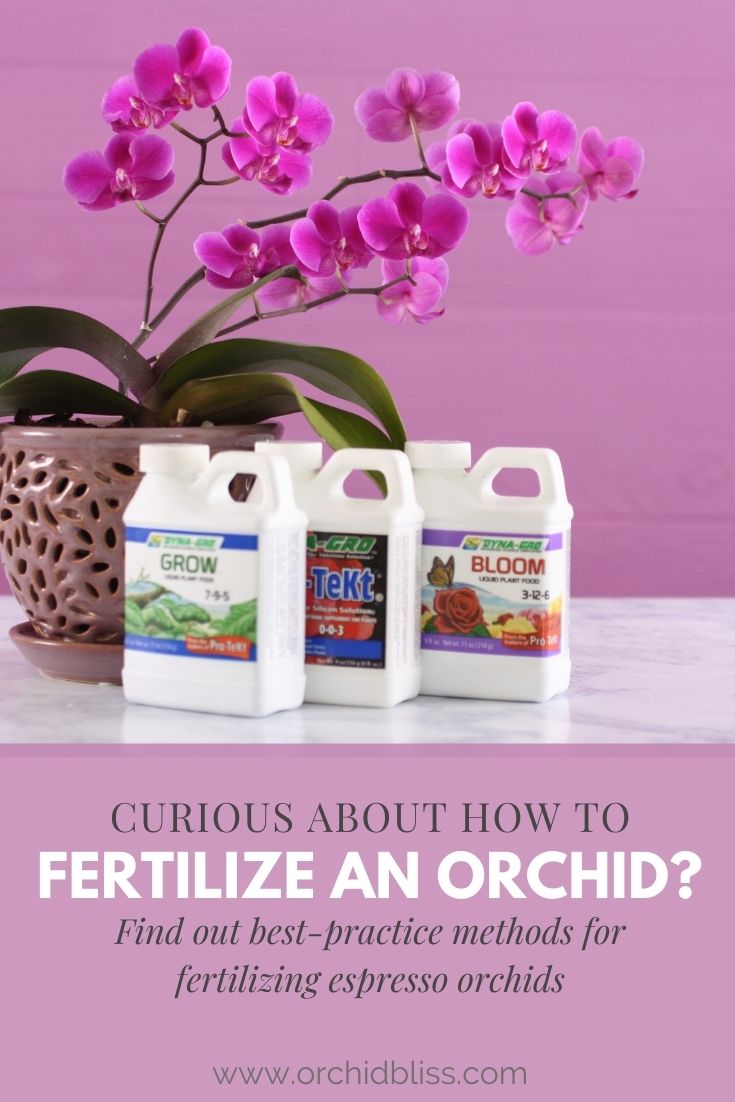
Espresso orchids may be finicky, but they still need a top-up on nutrients. To properly feed your delicate orchid, an orchid fertilizer like the Dyna-Gro Orchid Pro fertilizer is diluted in water and provides more than enough nutrition for the tiny espresso orchid. Apply the orchid fertilizer once every two to three weeks to a happily-growing plant.
Orchid Soil Mix
The time will come when you will need to re-pot your espresso orchid. Even if you aren’t increasing the pot size of your plant, you will need to replace the potting mix at some point. The only acceptable medium for potted orchids is well-draining. It can consist of bark, moss, perlite, and more, as long as it doesn’t hold onto water like regular potting soil.
To re-pot your espresso orchid, you’ll need to remove it from its current housing. This process can take a bit of wiggling, but don’t be scared. If you aren’t breaking roots or stems, you’re doing just fine. CLICK HERE to learn more about how to pot your espresso orchid.
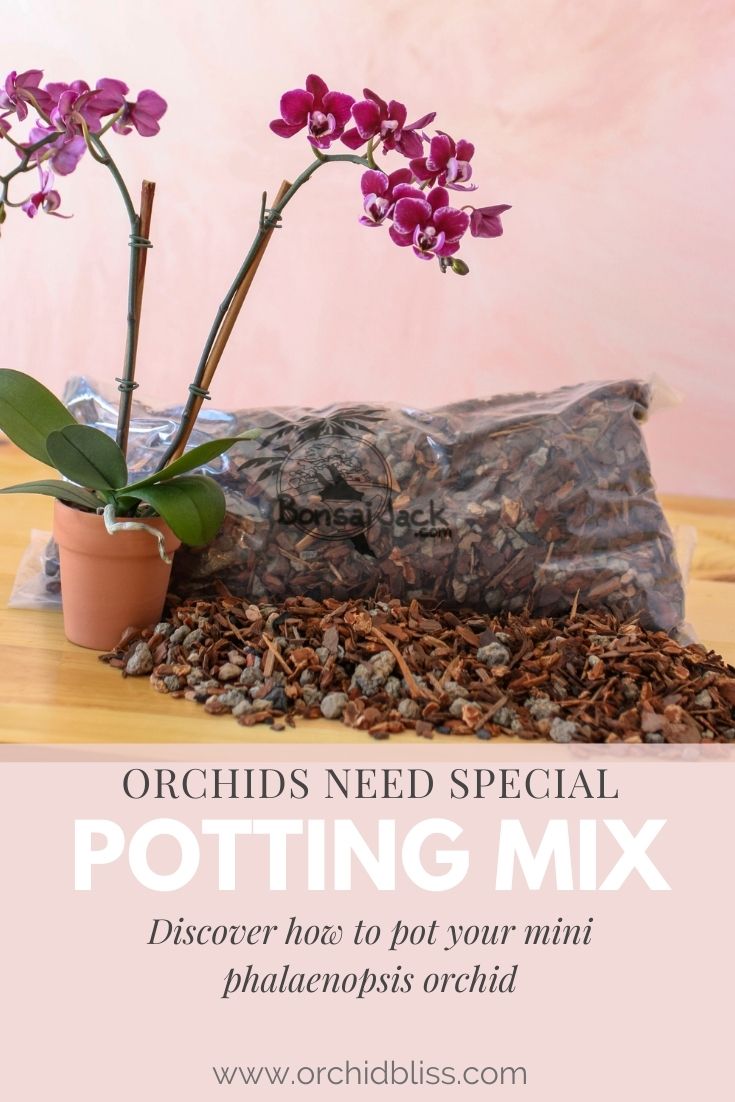
Line the new pot, or re-line the original pot with a layer of potting mix about an inch thick. Gently replace your orchid and fill in more soil around the roots. Because orchid potting soil is so chunky, you’ll likely have to shake the container a bit to get the soil to settle at the bottom of the pot.
Top off the plant’s base with more potting soil, pressing firmly to make sure the orchid is secure. You may want to use a supportive stake to help keep your orchid upright while it works to adapt to the new soil. Two days after repotting, thoroughly water your orchid to rejuvenate it after the replanting procedure.
Espresso Orchid Basics
There are five basic things that every plant needs:
- Light
- Air
- Water
- Nutrients
- Space to grow
Each plant has a different required combination of the above components. Let’s take a closer look at what the espresso orchid needs.
Light
Espresso orchids enjoy bright, indirect light. They love to sit on the windowsill of an east or north-facing window, where the sun’s rays aren’t as powerful. An espresso orchid will quickly let you know if it receives too much sunlight, reacting with burned leaves and a significant droop.
An espresso orchid not receiving enough light will probably show stunted growth and is at high risk of root rot. When orchids don’t receive enough sunlight, they cannot photosynthesize sufficiently and won’t use all of the water in their soil. Water that sits in the dirt for too long will rapidly develop bacteria and poison your plant with root rot.
Air
Espresso orchids love warm, humid air. Generally, their preferred temperature range is similar to humans, which is around 60˚F (15.5˚C) at night and 75˚F (23˚C) during the day. Regarding placement in your home, most kitchens, living rooms, or bathrooms would fit this criterion.
Locations you should avoid placing your orchid include:
- Basements
- Windowless bathrooms
- Unheated spare bedrooms
- Drafty attics
Humidity is also a main component of air for orchids. Espresso orchids require a humidity level of at least 50%. Most homes sit at a moisture level of 30-40%. If this is the case for your house, you’ll need to supplement your orchid’s growth with consistent spritzing, a humidifier, or placement in a naturally humid room like a bathroom.
Some cities may already sit at a high humidity level, which will suit the orchid nicely. Another thing to note is that orchids hate dry heat. If your plant experiences temperatures above 85˚F (30˚C), you’ll have to increase the humidity to at least 70% to ensure your specimen doesn’t dry out.
Water
A requirement for all life on earth, water can make or break an espresso orchid. These plants are small but grow quickly. Phalaenopsis orchids, like the espresso, are much-loved for their ability to flower multiple times a year. This high growth rate also means that espresso orchids work through water and nutrients much faster than other types of orchids.
While we touched on watering methods earlier, we shall again sum up an espresso orchid’s watering needs. Note that these are the average needs for the espresso orchid in the growing season. These averages will decrease greatly in the winter.
Improper watering is often the cause of a droopy, unhealthy orchid. Click here to grab your cheat sheet to learn how to grow healthier orchids. It will be super helpful.
Soaking method | Once a week |
Watering can pour-over method | Bi-weekly |
Misting the roots | Supplement either method every other day |
Nutrients
Orchids are fascinating plants in the way that they get their nutrients. Most orchids are epiphytes, meaning that they absorb moisture and minerals through the air. Epiphytes don’t require soil to grow. Instead, they use their fine roots to anchor onto the surface of perfectly-placed plants.
In the wild, you’ll find orchids growing on shaded trees, moss, and fallen stumps, anywhere they can receive bright filtered light and precious vitamins in the air. It’s no wonder orchids like it humid. They can’t feed on dry air.
One of the trademark spectacles of the orchids is their air roots. These meandering cords reach out of the plant’s soil toward the space around their container. Many people trim back the roots, not expecting them to serve any purpose. These reaching roots are vital to the plant’s ability to find and absorb airborne nutrition.
Space to Grow
It wouldn’t be a very comfortable plant life if you didn’t have room to grow. Luckily, espresso orchids need such little room. You can essentially place them anywhere. It’s worthwhile to note that these plants prefer to have their root system a little crowded. It improves the root’s ability to soak up all the moisture so that none of the water can sit dangerously in the pot.
Space is the least difficult factor to fulfill when it comes to espresso orchids. They even make a great van life plant, as long as your ride is relatively smooth.
Reading Signals From Your Espresso Orchid
Plants speak a language that you may not be familiar with, but you can hear loud and clear if you only listen. Most people have a natural affinity for spotting an unhappy plant. You can see it now, brown, shriveled, about to crumble. We know this plant isn’t happy without necessarily knowing anything about plants.
Black Spot on the Crown
A black spot on the orchid’s crown – the single stem where the leaves grow from – is the first sign of crown rot. If left unchecked, the rot will spread, and the orchid will die. If you take action immediately, you can stop the spread of disease.
Here’s what to do when the first sign of crown rot appears:
- Cut back on watering.
- Check to make sure the roots are healthy.
- Avoid getting water on the orchid’s crown when watering.
Brown or Black Roots
When you remove your espresso orchid from its decorative pot for its weekly or biweekly watering, you should always check the appearance of the roots. If any of the roots in the container appear brown, black, or feel mushy to the touch, you’ll need to perform restorative measures immediately. These are symptoms of some bacterial or fungal infection, often root rot.
You’ll need to remove the plant from the pot and cut off any dying roots with a clean pair of gardening shears or kitchen scissors. Spray the roots with a solution of hydrogen peroxide and water to sterilize the open roots, and then repot the orchid in fresh soil. Be sure to disinfect the pot before replanting, as harmful bacteria will also hang onto the surface.
Tip: After trimming your orchid’s roots, refrain from fertilizing for three weeks. The open roots are even more sensitive to fertilizer burn than usual.
Yellow, Brittle Roots
Very pale yellow or cream roots brittle to the touch is a sure sign of low moisture. Whether your plant has not been watered enough or has been struggling to survive in low humidity, the cause is lack of moisture.
You can attempt to fix this by providing your espresso orchid with generous soakings twice a week for the next month. Spritzing your orchid between waterings will also help rejuvenate the leaves. After two weeks of the liberal dousing, cut off any roots that remain discolored and brittle.
Dark Green Leaves
An espresso orchid should have pleasant olive-toned leaves. Think Castelveltrano, not Kalamata. If your miniature orchid’s leaves reflect a deep green tone, it’s a sure sign of a lack of light. While espresso orchids can survive with less light, they will by no means flourish.
Move them to a brighter location for a few hours every day before relocating them permanently. Adversely, you can also buy a plant light to make up for the lack of sunlight.
Red-Tinged Leaves
If your espresso orchid has olive-colored leaves that are tinged red, that is not a good sign. This appearance generally signifies too much light, and your plant is at risk of burning.
A burned espresso orchid will quickly enter dormancy to protect itself from adverse elements. A rapid dropping of flowers, a faded appearance, and red-ringed leaves mean your orchid needs some TLC as soon as possible.
As with the lack of light, a drastic change of scenery should be avoided. You should take the next three days, at least, to acclimatize your orchid to a new, lower level of light. Though it may take time, your orchid will return. Be patient and continue your regular care. The next bloom could take six months to appear.
Lack of Reblooming
Other than overheating, a sure sign of an unhappy plant is a lack of blooms. Phalaenopsis orchids, espressos included, are so popular because of their nearly year-round blooms. A lack of light almost always causes an espresso orchid that is late to bloom. If your plant doesn’t have enough light, it doesn’t have enough energy to create blooms.
It could also be that your plant doesn’t have enough temperature variation. An orchid that lives at 70˚F (21˚C) day and night won’t have any notion of the season’s change. It’s usually these changes that trigger a bloom. Try and place your orchid in a cooler area every night for a week. This procedure is usually enough to convince your orchid that it is time to reproduce or make flowers.
Conclusion
Espresso orchids are the adorable little sisters of the phalaenopsis orchid. These small plants only reach about half a foot (6″) in height. With lots of indirect light, humidity, and well-draining soil, these dainty orchids can provide you with colorful blooms throughout the year.
To help you further, start by downloading my free cheat sheet to see where to cut the orchid flower spike after blooms have faded to trigger re-blooming. Click here for the cheat sheet. It’ll be super helpful.
Sources
- Phalaenopsis Care Card
- SFGate: How Big Do Orchids Get?
- Mind Body Green: Your Plant Misting Questions Answered: Which Plants To Mist & When
- Let’s Talk Science: Needs of Plants
- Sustainability: Reduce Heat Gain Through Windows
- Indiana Public Media: How to Fight Root Rot
- Texas A&M: Urban Tarrant Horticulture
- Science Direct: Epiphyte
- Serious Eats: A Beginner’s Guide to Olives

